#it's hard to balance character & systemic analysis
Explore tagged Tumblr posts
Text
okay, it is kind of pissing me off when people insist Vi went with the Enforcers because she wanted to join them and side with Piltover and move up in society, and not because it was the only vehicle available for her to go after Jinx and solve the problem she created
(also, Vi does not want to kill her sister: she is driven by guilt. Vi feels she has a duty to stop further destruction and death from the monster she thinks she created. Jinx told Vi that her sister is gone and only Jinx, the monster, remains, and Vi believed her. After s2ep3, I don't think either of them believe that anymore)
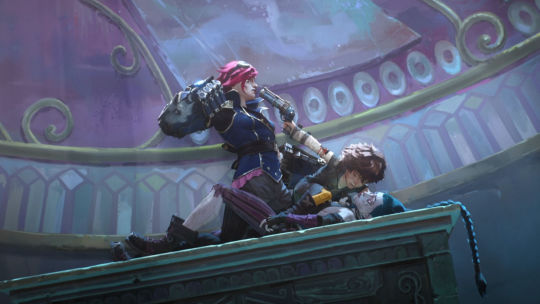
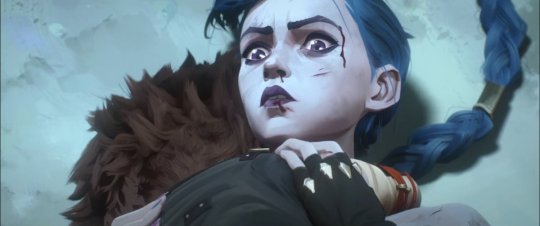
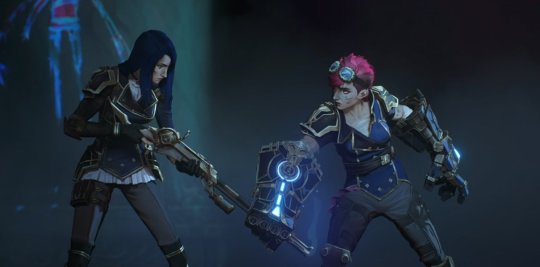
Vi still detests the Enforcers. You can plainly see on her face (and through her words!) that she does not want to be there. She just wants to get this over with.
if anything, Vi was trying to support Caitlyn, who is one of the only familiar things she has in her life at this moment. Her family is dead, she thinks her sister is gone, and the Undercity is barely recognizable to her - but Caitlyn was there. So, Vi took a gamble on sticking with Caitlyn, the seemingly sweet girl from Piltover who has sympathy for the Undercity, sees Vi's good heart, and helped Vi when she didn't need to.



Vi resigned herself to join Cait's enforcers, compromising her morals, hoping to be a positive influence. But the second she made a decision for herself, the second she stopped Cait from shooting a child, Caitlyn discarded her
she's lost, trying to find her footing wherever she can. Vi has been scrambling to attach herself to any scrap of familiarity since escaping Stillwater, and now she's left alone, in the dark, again
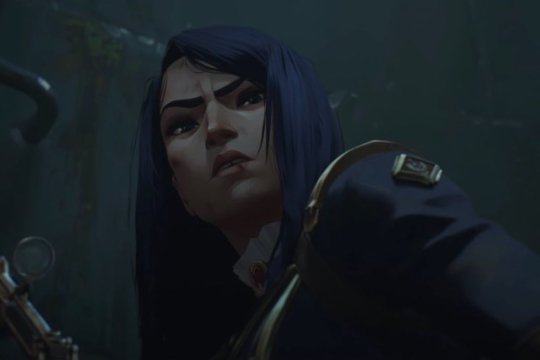


#cl thoughts#it's hard to balance character & systemic analysis#I hope I'm addressing this adequately#vi joining the enforcers is a betrayal and she knows it#but she's not happy about it#arcane spoilers#arcane season 2#arcane season 2 spoilers#vi arcane#vi arcane analysis#caitlyn kiramman#caitvi#it's not defensible but it's frustrating to see people insist Vi had super selfish malicious intent when she clearly did not#it's certainly somewhat self-serving but not in the way proposed#girly doesn't give a fuck about climbing the ranks she just wants somewhere to be#jinx arcane#vi and jinx
118 notes
·
View notes
Text
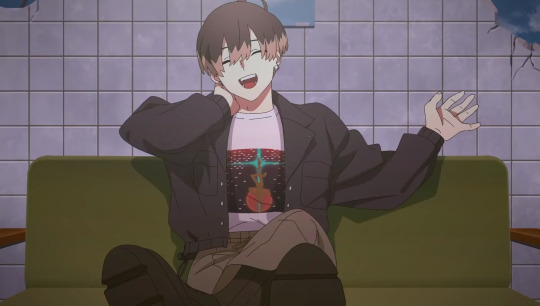
Mikoto Kayano as a Character Design.🧵
This is just one of many parts of my comprehensive analysis of Mikoto Kayano.
Mikoto Kayano is what I would call a high-concept character. What does high-concept mean?
✦ High-concept works tend to be attention-grabbing and appeal to a broad audience, often because they can be easily understood and appreciated on a surface level.
✦ The idea behind the character design may be simple or generic on the surface, but upon closer examination, it reveals intricate details and nuances that add to its complexity and depth. This can make the character design stand out and be memorable to audiences, even if the character's appearance is initially unremarkable or conventional.
Examples of high-concept: (For the inexperienced)
✦ In terms of illustration, Composition (Golden Ratio, Rule of Thirds, etc.) is like a puzzle that the artist puts together, with each piece adding to the overall picture. The main focus is usually in the center of the image or off-center to create visual interest, and other elements are arranged around it in a way that enhances the story being told to reward the inquisitive.
✦ In video games, Platinum’s Hideki Kamiya (Bayonetta, Devil May Cry, etc.) is known for this exact concept. You can finish the game by just casually engaging with mechanics, but if you look deeper into the systems, you are able to execute flawless stylish moves that are very rewarding to execute.
Whenever designing characters, Japan tends to place a strong emphasis on the following:
✦ Name Symbolism - The names are usually a great clue to what a character is about. This includes potential wordplay.
✦ Blood Type - Determines the type of personality they have and their chemistry with the rest of the cast. Think of it as the equivalent of Zodiac signs.
✦Mikoto Kayano Name Breakdown
✦ Kanji - 【榧野 尊】 ✦ Katakana - 【カヤノ ミコト】
✦ To get the definitions for the kanji used in this document, I used Goo and Jisho.

【榧】Kaya ✦ Japanese nutmeg tree (Torreya Nucifera) ✦ Flowers bloom around April, and elliptical fruits are produced in the following autumn. The fruit is used for edible oil and hair oil, as well as for food. The wood is hard and used for construction materials, furniture, Go and Shogi boards, and as a carving material.
✦ The flower language for Kaya is “effort”
✦ In Go, the concept of "building a house" refers to creating a territory on the board by enclosing a certain area with your stones. This can be seen as analogous to building a house, where you create a defined space for yourself to live in. The process of building a territory requires strategic thinking, and players must balance offensive and defensive moves to secure the most advantageous positions on the board.
✦ In Shogi, there is a similar concept called "castle." Where certain pieces are used to create a fortress-like structure around the king, making it difficult for the opponent to attack and capture it.
‼️ I feel like anyone with DID/OSDD understands what it feels like. I hope this could be a good allegory for you to use? Although I have shown this example to people with systems, feel free to leave your own thoughts too.
"Kaya no soto" (茅の外) is a Japanese idiom that literally translates to "outside the fence made of kaya grass". The phrase is used to describe someone who is uninformed or ignorant of a situation, or who is excluded from a group or organization.
The kaya grass referred to in the idiom is a type of sedge grass that grows in Japan and other parts of Asia. Historically, it was used to make fences and walls, and was seen as a symbol of exclusion or separation.
The idiom "kaya no soto" is often used in situations where someone is unaware of important information or events, or is not involved in a particular group or community. It can also be used in a humorous or self-deprecating way to indicate one's own ignorance or exclusion.

【野】 No ✦ Field or plain. "野営 (yaei)" means camping, and "原野 (genya)" means wilderness.
✦Field, cultivated land. "野菜 (yasai)" means vegetables, and "田野 (denya)" means rice field. ✦ Folk, civilian. "野党 (yato)" means opposition party, and "在野 (zaiya)" means out of office. [Antonym] Morning. ✦ Natural, wild. "野生 (yasei)" means wild, and "野鳥 (yachou)" means wild birds. ✦ Rough, uncivilized. "野蛮 (yaban)" means barbaric, and "粗野 (soya)" means uncivilized. ✦ Ambitious, exceeding one's status. "野心 (yashin)" means ambition, and "野望 (yabou)" means aspiration. ✦ Classified area. "視野 (shiya)" means field of vision, and "分野 (bunya)" means field of study. ✦ Abbreviation of "下野の国 (Shimotsuke no Kuni)". "野州 (Yashuu)" means Shimotsuke Province. 【Kanji 2】Sho Countryside villa, summer house.
✦ The kanji 【野】 means "field" or "wilderness" in Japanese. It can also refer to "rough" or "uncivilized" behavior or nature. In some cases, it is used to indicate that a plant or animal is in its natural, wild state. It can be combined with other kanji to create words such as 野菜 (yasai) meaning "vegetables," 野生 (yasei) meaning "wild" or "untamed," and 野球 (yakyuu) meaning "baseball."
✦ Added to nouns representing people to express contempt for their uncivilized behavior. "野幇間 (daiko)" means wild street performer, and "野育ち (no sodachi)" means someone who grew up in a rough or uncivilized environment.
✦ It can also be used to combine with words like spacious farm or field to create an expression. "朝早くから野に出て働く (asa hayaku kara no ni dete hataraku)" means going out to work in the fields early in the morning.


✦【尊】Son (Wu) (Han) [Kun] Tattoui, Toutoi, Tattobu, Toutobu, Mikoto
✦ High value or rank; noble. "尊厳" (dignity), "尊属" (noble family), "尊大" (majestic), "尊卑" (social status), "独尊" (supremacy). ✦ To respect and cherish. "尊敬" (respect), "尊崇" (reverence), "尊重" (esteem), "追尊" (posthumous honor), "自尊心" (self-esteem). ✦ A word expressing respect for the other person's matters. "尊翰" (esteemed writing), "尊顔" (honorable face), "尊兄" (esteemed elder brother), "尊体" (respected body), "尊父" (honorable father), "尊慮" (thoughtful consideration). ✦ A word used to express reverence for Buddha or noble people. "三尊" (three pure ones), "至尊" (supreme honor), "釈尊" (Shakyamuni Buddha), "世尊" (World Honored One), "本尊" (principal image of worship).
✦ One very interesting to note is Mikoto’s name and its association with deities. To be specific, the Three Pure Ones. They are often portrayed as elderly deities robed in the three basic colors from which all colors originated: Red, Blue and Yellow (or Green) depending on personal interpretation of color origins by additive or subtractive means.
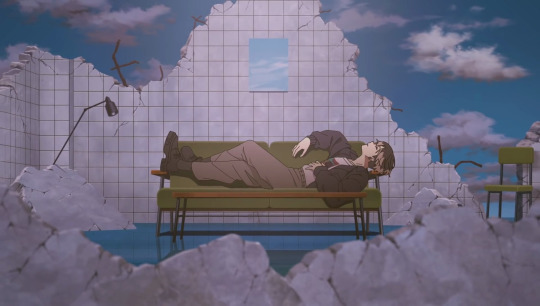
✦ The impression Mikoto’s name gives is, “Someone who has a strong sense of hard work and dedication.”
But here are also possible interpretations of his name:
✦ Noble of the Torreya Fields. In this interpretation, the name can be seen as suggesting a person who is noble and respected in the fields where Torreya trees grow.
✦ Revered One from the Kaya Field In this interpretation, the name emphasizes the noble or revered status of the individual who comes from a place where Kaya trees grow (Kaya Fields).
✦ Honorable Torreya Tree Guardian If we consider 尊 (Mikoto) as representing honor and reverence, it could be interpreted as someone who is an honorable guardian or protector of the Torreya trees or the fields they grow in.
✦ Divine of the Torreya Fields In this interpretation, Mikoto as "divine" signifies someone who possesses divine or sacred qualities, and is connected to the fields where Torreya trees grow.
✦ Divine One from the Kaya Fields This interpretation suggests a person with sacred attributes originating from the Kaya fields.
✦ Divine Torreya Tree Guardian The name could be interpreted as someone who is a divine or sacred guardian or protector of the Torreya trees or the fields they grow in.
✦ A lot of Mikoto's name meanings is about PROTECTION.
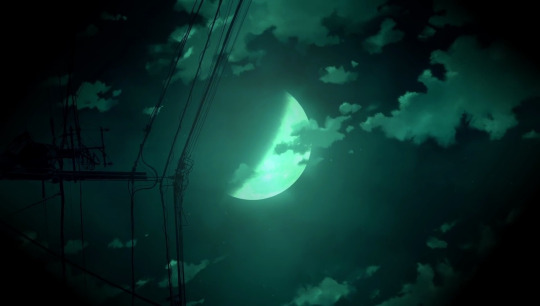

Goroawase (ごあわらせ) is a Japanese wordplay technique that uses the first kana character of each word to create a new word or phrase. For Mikoto’s name (カヤノ ミコト) these would be the meaning:
✦ カミ (KAMI): "kami" (神) can mean "god" or "deity." ✦ ヤミ (YAMI): "Yami" (闇) means "darkness" or "shadow." ✦ ヤコ (YAKO): "Yako" (夜光) means "night light" or "luminescence."
Mikoto also has symbols that connect him to the Polaris Binary Star (if I am remembering this correctly). Let me show you a visual about Mikoto as a character.
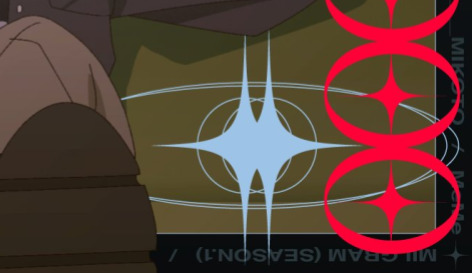

✦Mikoto Kayano's Blood Type: AB

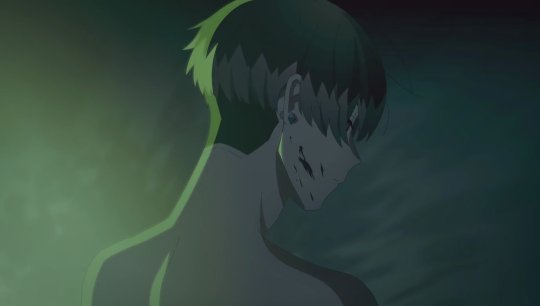
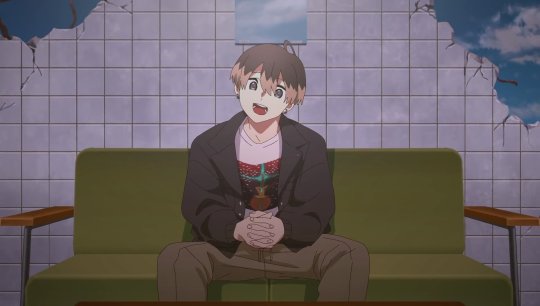

Mikoto Kayano's is Blood Type AB. The only one. It already represents him as an outcast and someone highly unique.
In Japan, the concept of blood type personality theory, known as ketsueki-gata, has gained significant popularity since its introduction in the 1920s. Although the theory has no scientific basis, many people in Japan believe that an individual's blood type can determine their personality traits, temperament, compatibility with others, and even influence their career and romantic prospects. The idea is not dissimilar to the way some people in Western cultures view astrological signs.
Blood type AB is one of the four primary blood types in the ABO blood group system, along with A, B, and O. According to Japanese beliefs, people with blood type AB possess unique characteristics due to the combination of both type A and type B antigens. These traits can be both positive and negative, and individuals with this blood type are often perceived as:
✦ Creative and artistic: Type AB individuals are thought to be highly imaginative, innovative, and capable of thinking outside the box. They may excel in fields that require original ideas and creative problem-solving.
✦ Rational and analytical: People with blood type AB are often seen as intellectually curious, possessing strong analytical abilities and a keen interest in understanding complex subjects.
✦ Calm and composed: Type AB individuals are believed to maintain a sense of emotional balance and are not easily swayed by external events or circumstances.
✦ Ambiguous or mysterious: Due to the mix of traits from both type A and type B blood groups, individuals with blood type AB may be seen as enigmatic and difficult to predict.
✦ Diplomatic and adaptable: As type AB individuals carry characteristics of both A and B blood types, they are thought to be adept at navigating social situations and building bridges between conflicting perspectives.
✦ Aloof and detached: On the negative side, people with blood type AB might be perceived as emotionally distant or reserved, which could make it challenging for them to form close relationships.
✦ Indecisive and disorganized: The blending of type A and type B traits may lead to difficulty in making decisions, a lack of focus, or trouble maintaining an organized lifestyle.
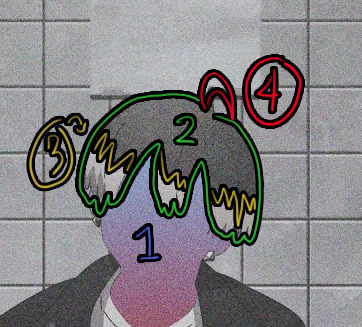
✦Mikoto's Character Design and DID
Mikoto is often described as someone who is "Mass produced" and an "Everyday Man."
But despite this, Mikoto's hair is a great way to describe his complexity. Based on what we know, here's how I would break it down.
You must be wondering why the Ahoge is seen as a separate identity. With character design, they are considered as a character by themselves. When you register them for ownership, the Ahoge or "Character Mark" would be the one registered. The rest is considered generic.
This is Mikoto in a nutshell. Try removing the ahoge, he is almost unrecognizable.
In short, this is genius character design. More explanation about the RGBY colors later on.
✦ We will end this analysis here for now. Please look forward for the next part!
#milgram#milgramtranslations#milgram analysis#milgramtheory#milgram theory#milgram translation#kayano mikoto#mikoto kayano
104 notes
·
View notes
Note
I don't get why Dream found his purpose so hard it's not like dreams are that fundamental and they don't have any real power. They are just dreams. I could understand if he was any of the other six. Delirium is in charge on the human mind, Desire and Despair in charge of the human emotion, Destruction is in charge of destruction itself, Destiny is in charge of everyone's fates and of course Death who is in charge of death. What is Dream in charge of the unreal.
Lol this sounds more like a question for Neil Gaiman, since he's the one who put the guy in the situation to begin with. But, I think I can offer a bit of an explanation/analysis.
I do agree that Gaiman's choice of division for the Seven Endless is a bit odd and arbitrary. I would've had Death/Life and Destruction/Creation all be one person, for example, and given the whole "defines their opposite" thing I have no idea why Delight was ever a separate person from Despair (since wouldn't the opposite of despairing over something be delighting in it???). The reason he named Dream "Dream" is partly due to deciding on a "D" theme for all their names (Destiny was a preexisting DC character he used, so presumably it all came from there), and partly because The Sandman started as a reboot of an old dream-themed superhero comic but ended up very, VERY different by the time it actually went to print. Dream's weird helmet is likewise a leftover from that superhero's mask design.
As for why he's important and why his job is hard: he doesn't just handle dreams as in "the crazy shit your brain projects when you sleep." I would define him more as Ideas, or Culture, or maybe Mythology, or Social Constructs. He handles the intangible aspects of human society that nonetheless have MAJOR impacts on how humanity functions. If Destiny handles the bare bones "what happened" of history, Dream handles the more complex "WHY did that happen?" of history. He handles the societal values, religious myths, and really popular stories that affect people's actions beyond simple emotions. The human mind is more than just emotions or base sanity/insanity (which is more how I'd define Delirium's realm), and that's what Dream's purview is.
And as for why that's depressing? Oh god. Listen to some humanities majors talk about what they're studying sometime... historians, cultural studies majors... it's depressing as FUCK. It's one thing on its own to learn about some horrific historical event, like, say, a genocide (pick any of them really, there's a lot...). But then to find out why so many people died horrific deaths? Nothing more than an idea. A construct. Someone had the idea that the other group was inferior, and needed to be wiped off the face of the earth, or permanently enslaved. You'll read primary documents by genocide perpetrators or enslavers, and where you expect to find frothing hatred you instead find just plain, basic, disgusting belief. "It's a fact of nature" or "god willed it" or "this is how we've always done things"; they don't consider it their fault, it's just fallen to them to continue this system and they aren't going to question it. It's a comforting story to tell themselves.
We see this aspect of Dream at the Cereal Convention, where he is able to strip the serial killers of their beliefs/constructed narratives to make them realize how horrific their actions are.
And Dream has had to deal with that horrible side of humanity as his job, never having any day off because he IS his job, for all eternity. As much as I point out that he's an asshole a lot of the time, it's honestly a miracle he managed to be as relatively kind and balanced as he is. Some of the worst things humanity has ever done were based on ideas and social constructs alone, and he has to deal with that, and possibly BE that. No wonder he's depressed as hell.
Things that are "unreal" do not lack importance or influence in reality. Ideas are incredibly, terribly powerful, and it is unwise to forget that.
22 notes
·
View notes
Note
Hmm, that's a good point, the main difference between those power systems are about that ones is about creativity and one if about training the power to do better, it makes for an interesting if subtle contrast.
One Piece's power system would be closer to Jojo's in that sense, while BNHA's is a little bit closer to Dragon Ball's, I guess.
On a related question, do you think that more characters that focus on creative use of their power would make BNHA more interesting?
I feel that series like HxH, One Piece and Jojos benefit a lot from that approach, and at first glance BNHA seems like a setting that would lend itself well to that sort of thing, but giving that it's supposed to be a super hero setting, a more traditional approach to battles makes a lot more sense, I guess.
Not to mention easier to think about in a weekly schedule. Oda is a monster for managing that sort of stuff, even Araki does Jojo in a way less intense pace these days, not to mention the whole deal with Togashi's health.
Honestly the Quirk system lends itself to more creative fights like those from HxH about trying to identify and exploit the enemy's weakness, especially with the emphasis that was put on Midoriya's Hero Analysis early on. Figuring out and breaking down Quirks is his whole thing.
I've mentioned it before, but imagine if instead of punching Flect Turn really really hard, Midoriya broke the floor under him and dropped him down a pit? Or hit him with air blasts to keep him off balance? Or grabbed him by his Support Gear and threw him?
Remember how he outmaneuvered Gentle by memorizing where he put his air trampolines? Remember how he threw Overhaul in the air so he couldn't touch anything?
What if he smashed Muscular's fake eye and blinded him, then used his own strength against him by luring him over a cliff?
Quirks as a system work for fights based around weakness exploitation and strategy, but we don't ever get fights where that happens
22 notes
·
View notes
Text
If (hypothetically speaking) a guy (not necessarily me, but whoever's doing it would definitely be very smart and handsome) were to make a game about were-creatures (guess what it's inspired by) in an urban fantasy setting (ft. a lot of fighting on both the social and physical front and sick-ass powers), how would you like the player characters to be handled in terms of mechanics?
For context: I'm planning on doing a splat type deal (like a character class if this somehow breaches containment from my normal sphere) with your species being your splat. This will determine powers and other benefits you'll have access to. Uncertain if it'll function on an x/y splat axis, this is still very early development phases and honestly I need to hack out just how I'm going to handle everything before we get to that step. I'm torn on whether or not I like the idea but I feel like the secondary solution here is to just do both.
And to be clear, I am very set on having a monster secret society here. I don't like the idea of them being individualistic or isolated, so having the splats be culturally cohesive in some way is very important to me. I'm also somewhat set on having a medium-to-high crunch system here, rules-lite monsters has been done a bit more extensively than I'd like. This will almost definitely be an in-house system as well.
So, with that said, here is my cost-benefit analysis for the three options. You might have to pitch me the secret fourth thing but I promise I will at least consider those.
Folkloric Archetypes
As you are probably very aware if you've heard me talk for more than five minutes, I really like religious studies. It's very easy to come up with general roles that certain animals can play within human folklore and mythology. Tricksters, warriors, psychopomps, and so on. The idea here is you get fairly abstract powers (like being able to talk to ghosts if you're a psychopomp) and get to roughly pick what species you might be that fits into that general archetype.
Bonuses: Permits a very wide variety of potential animal species. Lots of wiggle room in terms of what species can be what and I could just give general examples. Allows people to use their own animal species I might not have thought of.
Drawbacks: Extremely difficult to give broad archetypes any specific lore focus or concentrated society. My preference is towards simulationist systems and it'd be very hard to come up with ways to handle form bonuses since that will absolutely be a thing, what's the fun of a shapeshifter system if you don't get to literally go beast mode? Not as much room to expand on roles either since there's far less you can do with general archetypes.
Species-by-Species Case
Kind of self-explanatory. You get a grab bag of well-known species heavily associated with shapeshifting (wolves, hyenas, cats, bears, possibly seals, et cetera) and pick one you like. You'll still get at least some abstract powers, though.
Bonuses: Lends itself well to mid-to-high crunch simulationist thing. Easy to incorporate actual fun facts about what the animal in question is capable of and make those innate abilities. Easier to justify in an urban fantasy setting as having inspired various folklore bits IRL, meaning they feel like they have a natural place in the setting. A lot easier to justify each group having highly specific cultural practices, making the options feel more unique.
Drawbacks: Way less freeform in terms of character options, meaning player options are more limited. Simulationist usually means tons of tweaking stats and having to fuss over game balance while remaining somewhat realistic, so lots of cognitive overhead for the designer, who may or may not be me.
Both (usage of an x/y splat axis?)
Yeah. My first thought is that in this case the species splat would be like..."giant predator" or "stealth ambusher" or whatever, and then you have a cultural splat that's more like what your folklore role is (so the whole "trickster" or "psychopomp" thing.)
Bonuses: Best of both worlds...? Maybe?
Drawbacks: Not sure how to handle the way shapeshifter culture would work here. Justifying something like a trickster bear seems like it would be difficult which could lead to some incongruities. oh god so many powers to make
5 notes
·
View notes
Text
Navigating the Terrain of Capital Gain: A Roadmap to Investment Success

Greetings:
The vital factor driving investors toward financial progress is capital gain, which is more than just a notion in the world of investments. With the help of this thorough book, we will take you on a journey to understand capital gain, revealing its nuances and practical methods for realizing its full potential. Factors Influencing Capital Gain:
A symphony of internal dynamics and external forces interact to shape capital gain; it is not an isolated trip. The trajectory of asset values is influenced by a convergence of factors such as economic statistics, market mood, firm performance, and global events. Furthermore, an asset's potential for capital gains is largely determined by its intrinsic characteristics, including its market demand, growth potential, and intrinsic worth.
Examining Capital Gains in More Detail:
Examining capital gains in more detail reveals two types: short-term and long-term. Due to their transient character, short-term gains—derived from assets held for a year or less—typically entail greater tax liabilities. On the other hand, investors are rewarded for their patience and foresight when long-term gains—accrued from assets held for more than a year—enjoy preferential tax treatment.
Factors Influencing Capital Gain:
A symphony of internal dynamics and external forces interact to shape capital gain; it is not an isolated trip. The trajectory of asset values is influenced by a convergence of factors such as economic statistics, market mood, firm performance, and global events. Furthermore, an asset's potential for capital gains is largely determined by its intrinsic characteristics, including its market demand, growth potential, and intrinsic worth.
Techniques for Capital Gain Maximization:
Investors employ a variety of tactics refined by experience and knowledge in their quest for capital gain optimization. The foundation of risk management, diversification, insulates investors from volatility and reduces downside risk. Due diligence and extensive study act as compasses, pointing investors toward assets that are undervalued and ready for capital growth. A long investing horizon also helps investors develop resilience and patience, which helps them weather market turbulence and benefit from compound growth.
Managing the Tax Landscape:
Investors must navigate the complex tax system as they go through the capital gain landscape. It is crucial to comprehend the tax ramifications of capital gains because they can have a big impact on investment returns. Investors can minimize their tax obligations and protect a larger portion of their hard-earned gains by utilizing tax-efficient investment structures, harvesting losses to balance gains, and strategically timing asset sales.
In summary, capital gains are the lifeblood of investments; they are teeming with possibilities and promise. Through a thorough analysis of its subtleties, a clear knowledge of its intricacies, and the use of practical tactics, investors can confidently and clearly traverse the landscape of capital gain. Equipped with intelligence, vision, and a healthy dose of perseverance, investors can set out on a path to financial success by utilizing capital gains to help them reach their investing objectives.
Learn more...
0 notes
Text
Sources & Significance 1_1.11 - Critical Analysis
Part 1 - Introduction:
Initially the piece largely tasks itself with outlining what interactive narrative is. It then posits 3 core research questions:
How does a computational system determine what should happen next in the narrative?
What does a computational system need to know about the fictional world and the user in order to reason about the user's narrative experience?
How does a computational system intervene in the fictional world to bring about an engaging experience?
Part 2 - Experience Management:
Defining the issues a coherent narrative and progressing events that build off one another create, especially when viewed in potential opposition to the player's agency. We move across player introduced inconsistencies (defined as events the system is unable to build from) brought about by the player's desires to change the story, test the system or potentially even brought about unknowingly. This posits the key challenge being the balance between player immersion through their ability to affect the narrative and the system's ability to ensure a coherent narrative. The introduced solution being a digital system here called an 'Experience Manager', somewhat of an autonomous surrogate for the author. This experience manager would shape the narrative on behalf of the player (who would be unaware of the Experience Manager's existence), intervening and diverting the path of the player through a branching narrative structure and NPC interactions in accordance with the Player's agency. The Manager would manage the narrative through 'world states' and the projection of the best possible narrative given by the player's agency. The Manager would then use hard or soft constraints on the narrative structure using pre-determined aesthetic considerations. This would essentially result in a 'penning in' of the player into a narrative path determined by their own actions.
Part 3 - Taxonomy of Approaches to Interactive Media:
Here the author addresses the variety of issues that may stem from creating an interactive narrative:
Authorial Intent
Virtual Character Autonomy
Player Modelling
Point 1 (Authorial Intent) concerns itself with the degree the author's intent may constrain the interactivity of the narrative and the sense in which a system can assume the creative responsibilities of a human author.

SEMANTICSCHOLAR. [Online]. Available at: https://www.semanticscholar.org/paper/Interactive-Narrative%3A-An-Intelligent-Systems-Riedl-Bulitko/8cc0b359ac723d819be3343b20df9c6beaaa7bee
Above is a figure displaying the constraint of authorial intent by systems, with the systems on the left catering more to the author's intent and the further right we go the more we focus on the player's narrative experience.
A stronger author's intent can ensure the quality of the experience (at least in accordance with the author's expression, potentially leading to greater immersion through a hand-crafted narrative). While greater emphasis on the narrative system increases greater agency for the player (potentially leading to greater immersion through interactivity). At the strong authorial intent end of the interactivity spectrum we find Choose-Your-Own-Adventure and related game systems. In these games the player usually moves from node to node on a branching story graph. Branches representing player choices, while the nodes are manually-authored sections of text as response to the designated choices. As more user interaction is added, there is the danger that these graphs go beyond human calculation and it becomes the experience manager's job to assume greater decision making authority. These can be managed through a Plot-Graph (a map of possible narrative trajectories) reacting to the player's actions through constraints placed on scenarios and can even nudge the player through direct interaction in the form of tutorials or hints. The author's intent now present more through the design of the Experience Manager and it's ability to determine and manage the trajectory of the story. The further we move along the spectrum the more total the experience manager's role in crafting a satisfying narrative becomes. This is the territory of generative experience management in which the Author's involvement in the narrative is much more general while the manager is responsible for generating the narrative. It may manage the experience through domain theory (a declaration of what is and isn't possible) and the world state (conditions that allow or disallow certain conditions) without any pre-determined understanding about the order in which changes occur. Through this system the experience manager will sooner or later encounter the 'boundary problem' (recognition and response to a player's attempts to deviate from the intended narrative). The Experience Manager is likely to respond to the Boundary Problem through intervention (an act by the experience manager that will prevent the player from crossing the narrative boundary) or accommodation (allowing the deviation to occur and creating a new narrative that eliminates any inconsistencies).
-
Point 2 (Virtual Character Autonomy) concerns the autonomy of NPCs within the system's framework. It strives to investigate the balance between an NPCs ability to act consistently within their own character while also staying true to the needs of the narrative.
This is an integral part of character believability (how easy it is for the player to suspend their disbelief that this is a personality-driven, intelligent being). This is apparent in the way the Character interacts with the environment and the player. While characters are an integral part of every story they can be at odds with the structure and systems. This paper posits two opposing key views. A focus on Strong Story: where virtual characters do not act without the guidance and permission of the experience manager. or Strong Autonomy: In which virtual characters are fully autonomous agents, untethered by the needs of the overarching narrative. Interactive narratives tend to fashion their NPCs in-between these two extremes. A strong story focus will allow the experience manager high leverage over the virtual world, able to act as needed to break down plot points into performable actions as necessary. While a strong autonomy focus will create a user experience driven by the actions of NPCs. This is referred to as an emergent narrative. This is particularly synonymous with Simulation games. Which usually do not require intervention and have much looser guidance from the experience manager.
Most interactive systems try to strike a middle ground. The paper posits The Façade as an example of a interactive experience that addresses this through the breaking down of larger plot-units into executable behaviours, with the experience manager providing coherence. The NPCs autonomously determine how the plot points are realised. Similarly The Automated Story Director is mentioned as an example of fully autonomous NPCs that are directed by the experience manager when required to ect in the interest of plot progression.
-
Point 3 (Player Modelling) regards the extent to which the system attempts to learn and react to the individual differences of each Player. Player models are considered abstractions blanketing the pattern of behaviour displayed by the player. This subsequently allows the system to tailor and manage the player's experience.
Different players will have differing preferences of how their narrative progresses. The experience manager may take this into account and predict a Player's narrative future, forming an abstract 'model' of the player's individual tendencies and preferences through a learning process. In this case particularly focused on preserving the author's intent. This process may be applied in order for NPCs to adapt behaviour or as justification for the experience manager to intervene for the player's benefit.
Part 4 - Discussion
The paper then posits 5 major open-ended questions:
How and when should [the experience manager] intervene in the virtual world on behalf of the user?
How will [the experience manager] generate narrative structures?
How would [the experience manager] encode human authorial intent and at what level of abstraction?
How would [the experience manager] incorporate believable characters into an interactive narrative framework?
How would [the experience manager] tailor narrative experiences?
0 notes
Text

Source: Bigelowandholmes.typepad.com Letter Drawing For Galileo Typeface Designed For Scientific American Magazine, 1985.
Letter & Spirit (My Analysis)
This article was an intriguing but perplexing read for me. It wasn't that it wasn't clear, but I got mixed up between some words and terminologies. It taught me the distinction between font and typeface. I don't know why they meant the same thing. In this reading, a few things stood out to me, one of which was Donald Knuth's early 1980s concept of meta font. Metafont was a piece of software that allowed users to create infinite fonts based on predefined parameters. The concept entailed drawing a single letter, revealing only a small portion of what was going through the designer's mind when the artist drew the letter. However, that single drawing comes with precise instructions and specifications on creating other new characters, even with variables like weight, slant, bend, Etc. This concept clarifies why certain types of fonts have specific dimensions all around their type design.
However, I appreciate that Douglas Hofstader challenges his viewpoint, which is mathematical in nature. I've always considered the creative process to be both rule-breaking and spontaneous. As a result, reducing type design to a mathematical process has limitations. However, Geoffery Sampson strikes a balance by stating that letterforms can be conceived as closed and open systems.
I could see some history of typography evolution from the reading. We know that typography began much earlier than calendars, in the form of inscriptions and woodcuts on surfaces. These calligraphic exercises could not be determined by proportion but by the artist's creativity and desires. On the other hand, typography has evolved to impose mathematically rigorous structures and adapt them to the demands of the press and other forms of technology. This evolution makes perfect sense, given that the tools used to create typefaces included rulers, T-squares, set squares, compasses, and protractors, resulting in very distinct angles and shape forms.
In the article, I noticed a need to soften the hard geometry with gentler type designs with a more humanistic feel. Futura by Paul Renner is one of these birth fonts. The possibility of other types of type design expressions began to emerge. This is fascinating for someone like me who is fascinated by unusual typeface designs. It is acceptable to change things up. I thoroughly enjoyed reading about Stanley Morrisin's audacity in changing the fonts for The Times newspaper design. One person must be willing to do something different for new things to emerge. Even if the difference is minor, it introduces a new style, whether noticeable or not.
I also appreciated the perspective this paper provided on what new means. The birth of something 'new' does not have to be drawn from scratch; it could be an amendment or drawing inspiration from various forms. Some fonts are rejigging of other fonts, which makes them distinct in their own right as long as it reflects the designer's aesthetic impulse at the time.
As a designer, the article on the letter and the spirit inspires me because I am free to reimagine things while there are design rules and structures. That's the allure of being a designer and, by extension, an author in my production.
0 notes
Text
How I write for the narrator (long post)
This isn't perfect advice, this is just what I do to make him sound canonical.
Every good fictional character has their own rhythms and cadences for how they speak. Word choice and pacing have a certain flow when spoken aloud. I notice in the script there are patterns that repeat. He has a tendency to do rapid fire "no"s, for example.
(ex. "Are you really just doing this for the achievement? Click a door five times? Is that all that you think an achievement is worth? No, no, no, no, no."
"Oh, no! Oh, no no no no no no no no no no no no, not again." (when the player re-enters the broom closet.
"NO! No! No, no, no, no, no, no, no! This isn't right at all! You're not supposed to be here, yet! This is all a spoiler! Quick, Stanley, close your eyes!" (adventure line when it leads you back to the monitor room)
Another pattern he has is switching between really short sentences and longer ones.
"Stanley waited. Hours passed. Then days. Had years gone by? He no longer had the ability to tell.
But the one thing he knew, for sure, beyond any doubt, was that if he waited long enough, the answers would come. Eventually, some day, they would arrive."
There are other patterns he has too, but they're kind of hard to put into words.
The narrator is also a dramatic MF, so when emotions run high, he really amps up what he's talking about.
"The moment he entered his manager's office, Stanley froze in his tracks. Not a living soul anywhere. Could he really be all alone? This was too much for Stanley to take; too much for any man to take. He fell to his knees, bursting into half-moans, half-sobs... the guttural retching of life from a man denied any hope, any reason to keep going." (Narrator, what the f*ck. we're- we're just standing here)
and
"No! He refused to believe it. He couldn't accept it; his own life in someone else's control? Never! It was unthinkable, wasn't it? Was it even possible? Had he truly spent his entire life utterly blind to the world?" (narrator~, your showmanship is, well, showing~)
He's also a sarcastic boi, which I usually downplay because I prefer the narrator's sweeter side. But it's still there.
"You too?! Unbelievable. I'm at the mercy of an entire species of invalids. Perhaps there's a monkey nearby you can hand the controls to? A fish? A fungus? Look, you can hammer out the details; I'm not particularly picky."
or
"Okay, I think we all know the drill by now. Blah blah blah, dark secrets, the keypad, Stanley pushes some buttons, oh hey, look, it's a new passageway! Quelle surprise!"
Another thing to think about is word choice. The narrator is someone I'd describe as erudite. He uses large words a lot. An example of large words that I can pull from the script include: "momentum, "warrants recognition", " examination of structural narrative tropes", "Physical malady", solace, catalyst, immense." And this is just from a quick glance at the script. I admit, it's a tricky balance. You want him well spoken, but not a jackass, unless you're specifically writing him to have maximum pretentiousness. Try and find words that not everyone knows, but can guess based on context if they're too lazy to look the word up. Eventually you can fine tune it.
The more you practice this stuff, the more intuitive it becomes. These days, when I write him, I can hear whether or not it sounds like something he'd actually say. and I think there was a post that modmad talked about when writing characters. There's a voice inside that will tell you whether or not what you're writing fits his character. "Listen to that voice, that's the character speaking" or something like that.
And a small confession: I keep the script open when I write these things in case I need to refer back to him or check in to see if what I'm writing fits. I don't have the entire script memorized (yet)
Again, this isn't a perfect system, but it's how I do it.
And if it seems like I've got a particular knack for it... I'm an english major who reads character analysis papers and looks at linguistic styles for fun. I love thinking about what makes characters tick. I have major original ideas that I'll one day write about. It's my dream to one day write professionally. I think it would be hilarious to be at a convention 10-20 years from now doing one of those author Q&As and tell the audience that I used to run a headcanon blog. I imagine the crowd would go wild at hearing that. I love writing, it's my other special interest/gen
340 notes
·
View notes
Note
Would you mind giving me a crash course on writing plurality? It interested me the moment I read your analysis on Raph being plural, even more so when I went after the links in the post.
I'm going to be completely honest and upfront first. Writing Plurality can be hard when you know nothing about the community or only know how the media presents DID. Plurality is a diverse experience, so it's going to challenge your choice of perspective in your story, word choice, and self-awareness when you're falling into demonization about the experience. Especially when characters can be stereotypical and fall into demonization "easily."
Writing a system is like writing a disabled character, a neurodiverse character, a cluster b character, a POC character, and so on. It takes a lot of understanding and discovering things you will have no idea how to explain because you've never experienced them or just don't know how to comprehend them. But the most important rule to writing any character(s) that go through things you don't is to remember that as long as you try your best, admit your mistakes, fix your errors, and never stop learning. You'll be able to achieve what story you want to tell with these characters.
Like any community, you have a lot of different opinions, and the views from the community you're trying to write about are something you've got to at least have a basic awareness of. Because understanding what may be seen as problematic or what might cause someone to come bursting into your comment section on a fic or so on will help you decide whether you're going to change what this person takes issue with or keep it despite their beliefs on it.
That doesn't mean you get to brush actual problematic things off, though. It's just a fine balance, especially if you're singlet.
But with that out of the way! I will try my best to give a basic crash course on how to write Plurality. Now, I'm a very understanding, patient, detail-orientated person, so if you or anyone else needs to ask questions or need me to "dumb" things down, please don't hesitate to do so! This is a safe space; I enjoy teaching people and bringing more acceptance to issues and experiences many people don't understand, so it's okay to make mistakes here with the intent of fixing them!
It All Starts With You
The first step to writing Plurality is to start with you. Now you might think, "What do I have to do about writing a system? Why does it matter that I've gotta start with myself first? :/" Well, I'll give a simple answer:
Everything you write reflects who you are as a person and what work you're willing to do for your writing.
Now, I don't mean reflecting yourself as in, "Oh no! You write about murders, so you must be a murderer!" No, I mean how you perceive yourself, the world, and others affect your writing.
An example of this is one of my favorite books, Life of Pi by Yann Martel. The author enjoys learning and believes in the ability to participate in multiple religions, so the character Pi in his story holds that characteristic, affecting how the story is written. I suffer from intrusive thoughts, so I write Mikey from ROTTMNT with pure O OCD (someone whose OCD doesn't showcase/have outward compulsions), which affects how I write his interactions with the environment and his internal dialogue.
Why this is important is because if you believe there is such a thing as an "evil alter," that only disordered systems are true systems, and/or that there's no such thing as Plurality and people are just faking it, it'll show in your work whether you want it to or not. So, it's important to tackle your stance on Plurality. How who you are and what you believe and participate in affect how you write a system.
I'll use myself as a perfect example! I'm very open-minded, but I'm very afraid of ghosts and demons. So when I learned that Possestive Systems were a thing, it scared me because the idea of being possessed makes me scared. I'm still afraid of demons and ghosts, but it no longer affects my interpretation and understanding of possessive systems.
I'm not religious, but I love learning about religion and how people interpret it so learning about Spirigenic Systems was super cool! I believe endo systems deserve respect and exist. I also think that persecutors do not deserve to be treated unfairly, negatively, and purposefully hurt by their systems or those outside the system. They also deserve respect and understanding.
This shows in my writing because I write Raphael as a diversian median system with a mixed origin with truamagenic and endogenic origins. I've made a few posts about Leonardo being a non-truamagenic system with non-religious spiritual connections to his ancestors (here, here, and here). I have even blatantly had Leonardo state in my Figuring It Out series the same perspective I have about Plurality:
In summary, Leo's brother is a part of a system, and if anyone were to ever make Raph, or Mind and Red for that matter, feel awful about that in any way, he and his brothers and sister would fight them without hesitation. There was nothing wrong with being a part of a system, and anyone who disagreed could eat a dirty, used pizza box for all they cared. Red and mind are a part of their family, and no idiot could ever change that.
Becoming aware of how Plurality makes you feel, think, and do is important, so while learning about Plurality, it's good to take time to assess why things make you feel this way or that way. Why you don't want to even try and write that experience but feel drawn to write about that one.
And, by the way, it's okay not to write some experiences! I don't write much about DID systems, but a friend of mine does! A part of writing systems is writing what is most interesting/relatable/understandable to you! There will always be some system that resonates with a characteristic you've written about, and it's okay if you can't write some system experiences perfectly or at all!
This leads to the other half of what I said, that who you are will affect the amount of work you'll put into writing about Plurality, and I shall use myself as another example to help you understand what I mean.
I am extremely passionate about learning about Plurality, so I am heavily involved in the community. I follow a lot of Plural blogs, have Plural friends, am a part of Plural discord servers, in activism, spend my time teaching others about Plurality, and have spent hours reading through Plural systems experiences over genuine, literal years. Because of this, I am very knowledgeable and deeply understand Plurality that not many singlets and even some systems have an understanding of. (This doesn't mean I am an expert and all-knowing, however. Please remember this. I am not a professional). I am willing to put years of research and interactions with the community into a piece of writing.
You may be the same way, or you may just want to only know enough to get the basics down to a T, which in my opinion, is valid if done correctly! Understanding how willing you are to dedicate yourself to learning about Plurality to write it is just as crucial as understanding how you feel about it and tackling any Pluralphobia or hatred you have towards the community/experience.
TL;DR: You have to figure out how you feel about Plurality and make sure you fix any issues you have towards or about Plurality. You have to understand how far you're willing to go to write Plurality, whether it's dedicating years to it or just wanting to know the basics.
Where to Learn About Plurality
Since I've spent years dedicating a portion of my life to learning and helping the plural community, I know a couple of ways that you can learn about Plurality for yourself and for your writing (because it is crucial you research before writing something). If you enjoy a laidback way of doing it, I recommend following blogs! If you want to read a lot, I recommend the dictionary! If you talk to the community directly, I recommend certain blogs, discord servers, and spaces where learning is the main idea!
Never just barge into any system/plural safe space with questions and concerns unless you know for certain they want to teach you. It isn't anyone's job to teach you or spend their day explaining what you want to know. They are beings with lives of their own, and they do not owe you anything. Respect is important; if you don't respect a system's time, boundaries, and wishes, you are in the wrong period. It is always important to ensure that you're asking questions and talking to systems that want to answer your questions with respect and patience.
Here are the blogs and sites I recommend interacting with if you're not sure where to start (I will take any mentions off if those I've mentioned would rather I not @ them):
@mixed-origin-system-culture-is
@funnier-as-a-system
@positively-plural
@dear-systems
@persecutorlifeandsupport
@endo-memes
@non-traumagenicsupport
Pluralpedia
Power to the Plurals
I am available to ask questions or get to know Plurality better, but as I said before, I am not an expert; I am not all-knowing; I am simply one opinion/experience in a sea of many, many others. Do not take my word as law and an end-all.
I recommend following and interacting with open communities specifically for the kind(s) of Plurality you want to write. This will help you in writing system experiences/struggles/achievements/interactions relating to those experiences you choose to write about.
TL;DR: To write Plurality correctly and to the best of your abilities, you have to learn about Plurality in the best way that suits your learning needs. Also, systems don't owe you anything. Respect them.
What to Avoid and How to Avoid it
Now, because there are a lot of stigmas, demonizations, misinformation, and discourse about systems, I am only going to talk about the main things you should always or at least try to avoid.
1) Gatekeeping Plurality
Whether you're a system or a singlet, this is extremely important to remember. It is not your place to dictate who, when, or what is deemed "Plural enough," especially system experiences you/you& do not experience yourself/yourselves.
You should avoid gatekeeping since it excludes systems from communities, help, and safe spaces. It's awful, and it hurts systems a fuck-ton. It's something that gets on my nerves because exclusion is literally the absolute worst. Excluding beings/groups/communities/experiences literally does nothing but hurt those just trying to exist. And it's never okay to hurt others on purpose.
As someone who's super open-minded in the way that I am, it's honestly difficult for me to gatekeep, but here's what I have heard that might help keep you from gatekeeping:
Not everything is about you. You may not get/need it, but that doesn't mean it doesn't exist/someone needs it.
The existence of something/someone doesn't mean less for someone else who isn't a part of that group.
If it isn't hurting anyone, it's not a problem. (There may be struggles or a change that needs to be made, but that doesn't mean it's necessarily hurting someone/a group.)
Everyone is capable of change, and that's okay.
Everyone makes mistakes, and that's okay.
Everyone is allowed their own opinions, and that's okay.
There are no rules for how being exist.
2) The So-Called Evil Alter(s)
We've all seen those characters in media that have that one side/alter who is slapped with the label of being evil. A perfect example is the Goblin from Spider-Man, the Beast from Glass, and literally any media you consume that has DID villainized. When writing Plurality, it is your job to avoid hurtful and harmful stereotypes such as the "Evil Alter."
The reason it's important to avoid falling into the stereotype is simple: It's overused, demonizes, stigmatizes, villainizes, and continues to push forth the idea that systems are to be feared. Systems are real and valid, and creating fear around their experiences and existence causes real-life problems. If you're choosing to write about marginalized groups (just like drawing, it should be something you practice/incorporate often), you must always keep this in mind. What you write affects real beings. Write responsibly.
The best way to flick a middle finger to the evil stereotype is by ensuring that a headmate is well-rounded, an actual individual instead of a plot device or just a flat character. It is okay to have characters who may fall into stereotypes, be a persecutor, or do bad things because they're a being; they're capable of such things. But you have to make sure to get across to the audience that they are not evil. You can do this by not having a headmate be the antagonist in the story or filling the common roles a villain does in most stories.
If you're incapable or aren't sure you can write a character like that, avoid writing headmates who can fall into being a villain in your story. If you're sharing your work publically, it's best not to incorporate it at all, but I highly recommend practicing privately on how to write demonized headmates in a stigma-free light in your own time and pace. You're going to fail at first; what matters is that you're trying.
3) Writing Only "Evil" or Antagonists as Pural
Similar to what I said above, even if you don't follow the "Evil Alter" villainization of a headmate, it's important to always pay attention if all or most of your system characters are villains/antagonists in your story. While having a diverse set of characters with various roles in a story is fine, it's important to ensure that you're not accidentally falling into the thin line of villainizing characters.
The best way to avoid this is to make sure you have an equal balance of plural characters spanning from "good" to "many shades of grey" to "bad." And to not use demonizing characteristics with "bad" characters but instead in good or a certain grey area. This will challenge you to break norms and think outside the box, depending on your character. But in the end, if you don't feel capable, practice! Learn! As long as you're trying, that's what matters!
4) Final Fusion
Many singlets don't know this, so I won't just link what Final Fusion is but define it. In the simplest explanation I can give, Final Fusion is when a system becomes a singlet.
I would avoid this in writing at all costs. The point of writing Systems isn't to make them singlet, and it's like learning how to write black characters to make them white. You just don't do that. You write systems to write about system experiences/have a genuinely diverse cast of characters, not to make their existence in stories an end goal to become one single being in a body.
If you're singlet, don't ever write about Final Fusion. In my opinion, it isn't your place to write about that; leave that to systems as it is a touchy subject and not one singlets should handle.
TL;DR: When writing about Plurality, avoid gatekeeping Plural experiences/groups, falling into evil stereotypes, making all your plural characters antagonists, and writing anything on Final Fusion.
General Writing Rules
How you write systems depends on what system you decide to write about, the headmates within that system, and any other characteristics you choose to add to the body or the headmates themselves will influence how you actually write things out. An example is how I write my Shard System (fic here).
First, my Shard System has polyconsciousness and can communicate internally, though it changes depending on who's talking and fronting. This leaves me having to find a format for the audience to know what is internal and external and who is specifically talking. I wrote that lil fic I shared while sleep-deprived, so it isn't the prettiest-looking format, but it's a format nonetheless, and that helps readers! I recommend having a key or using consistent formatting so readers understand what is happening.
Secondly, my Shard System dissociates when switching and co-fronting, so I describe the experience as I would an emotion or when a character is using their powers. When you have systems that have characteristics that affect the body and their perception when fronting or in the inner world, it's good to describe it like you would anything else! And if there's something significant about it or it changes depending on what perspective you're writing from, that's just as important as writing feelings or background characteristics!
Thirdly, systems have characteristics where they have a quirk where they'll write/type/speak in that quirk. For example, my Shard System has a few quirks where Red types in bold (hence why I wrote his dialogue in bold) and has a Spanish accent and a deep voice when fronting and in the inner world. Savage speaks in broken English, so it'll be very prominent when he communicates. Considering the little details about your headmates when writing them in your stories is never bad! Especially when it's a common quirk in systems to have!
Finishing Thoughts
There is nothing wrong with wanting to learn how to write Plurality or any other marginalized and demonized experience. You're going to make mistakes, and you're going to be a fool the first time you write Plural characters, and hey, it's all a part of the learning process! What matters is that you try and remember to check in to ensure you're not excluding or creating real-life problems in your writing.
This long-ass answer to your ask or anyone wanting to write about Plurality isn't meant to scare you off or overwhelm you; it's to simply inform you how you can write Plurality to the best of your ability. And like learning to do anything, it takes time and patience. Not everything will make sense right away, and it's expected that your first emotions learning about something you don't understand are fear, anger, and denial. But to grow as a person and as a writer is to tackle those feelings and remember why you're writing these experiences.
I write about plural characters and experiences because I love Plurality. I love it so much that I just want to express my love through my favorite characters and spend my time learning and consuming content on it. I write plural characters because I care so deeply for the plural community. I am passionate about giving them media and content they can enjoy, where they feel safe, heard, and understood. I write plural characters to destroy the idea that Plurality is something to fear and hide away when systems should take pride and be able to be wholeheartedly themselves. I write plural characters because I choose to. Because I want to.
Having a reason, no matter how "dumb" or "profound," for wanting to write Plurality is valid and good as long as it doesn't hurt real-life beings. And I am more than ecstatic to hear that you and others may want to write plural characters, even if you're singlet or not!
It isn't that hard to write once you get the hang of it and the moment you get the basic understanding of the system experiences you're trying to write. But, I want you to know that no matter how hard it gets, how challenging and maybe even overwhelming it may be, your best is enough, and your trying is enough. That doesn't mean you need to stop learning because you're always going to keep learning things until you die, but just know that your best is enough and will always be enough.
Thank you so much for reaching out, and I hope this long-ass post helped you or you&! I tried my best to cover everything, but if anyone else has anything more to add, feel free!
Thank you so much for the ask! <3
#fox speaks#long post#writing#fanfic#fanfiction#my writing#plurality#plural community#plural stuff#plural system#system stuff#shard system#system friendly#endo safe#tw swearing#tw final fusion#ask to tag#plural raph#plural leo#how to write#how to write plurality#I don't know how to tag this LMAO#thanks for the ask!#ask#a-scaly-troublemaker#pluralprose
70 notes
·
View notes
Text
Asuka and Misato in my mind over the years
Need to get this out my system real quick lol
I actually love the og Eva sereis so much, the first time I watched it was somewhere around 2014/2015 because I’d seen a lot of people gush about the third Rebuild movie and got curious, I was just getting into anime at that point as well as becoming more sensitive to lots of queer and mental-health related ideas. In any case, I enjoyed Eva a lot then, though I certainly didn’t get pretty much any of it. I felt emotional, and I definitely felt for the characters, but I definitely didn’t get them as people (especially Asuka - which I’ll get into later because I have so many thoughts on her)
But I rewatched a huge chunk of it somewhere around last year and it struck me how differently I saw and read all the characters and the shot compositions - it simply clicked in a very strong and potent way. And this wasn’t the first time I’d realized how much perception changes with lived experience, but it hit me really hard with Eva, I think. Especially because people still talk about it and very much like Twin Peaks analysis, everyone just focuses on putting everything into neat boxes and centers it very hard on Shinji as well. But it’s always in a very resentful way, either at Shinji or at the other characters, all of which I think leaves people with a very wrong impression of what the Eva viewing experience can be and how much the writing actually holds up.
I won’t get into full detail on every single character and I won’t make this about Shinji because that’s a bit central to the point I want to make anyway - Shinji is the main character, yes, but it’s not only about him. The series takes great pains to establish that Shinji is not other people’s top priority when they all have so many of their own personal issues. I think it actually balances out Shinji’s deep need for closeness and attention being a valid thing to want. That, no, it doesn’t make him a whiny bitch that he wants to be valued, to feel important, to have other people give him attention and see him as a valuable person to be around. But at the same time, great focus is put on how it’s not other people’s responsibility to provide all this to him and drop everything in their lives to coddle him. Well, Gendo is responsible to be there for his child, but that is definitely its own subject for a ton of analysis.
In short, the series neither condemns nor coddles Shinji, which is a really important nuance for the whole series. And it’s an important one to strike when it comes to the subject of growing up, finding yourself, connecting to others and understanding them even while you struggle. It’s good stuff, it’s potent stuff that I love quite a lot and is why I’m always so frustrated by all the extremely shitty takes on shinji i see in 95% of video essays on eva FROTHING AT THE MOUTH DO NOT GET ME STARTED
But onto the women! Because they are really important and despite all the merchandise, porn and objectification, they are very human and relatable.
I hated Asuka when I was a teen. I loathed her because she felt like someone’s Mary Sue OC and as a very shy, awkward, self-loathing teen, pretty much the exact same age as Asuka, I felt really affronted and... I don’t know if envious is the right word, but there was a very strong resentment for how seemingly smart, perfect, beautiful and confident she was. It felt like such an overidealized and unrealistic standart and a LOT of very sensitive nerves were struck and simply wanted to tear into her. I’m not sure I even sympathized with her all that much once her baggage was revealed, at the time.
But seeong her through the eyes of my adult self, I felt so much for her. Her need to be important, to be seen, to be perfect - to show everyone that she is mature, that she is grown up and can be loved and respected like an adult - it hit really close to home. Even outside of my personal perceptions and state of mind etc., Asuka’s behavior reminded me of so many other girls I have known and know even now. She filled me with such a familiar feeling of helplessness and need for approval. The lashing out, the standoffishness, the provocation, the insistence your grown up and /understand/. The frustration that the adults around you don’t treat you like one of them despite all your efforts and achievements.
And the way I, now an adult, looking back at that Asuka and seeing her pain and frustration but also knowing that no adult could treat her the way she wants to be treated because she’s simply not ready for that emotionally yet. The desire to protect her from things that are too adult, but coming off as out-of-touch and condescending. Ah... There are so many dynamics and emotions at play, it hits me in so many vulnerable places.
Switching to Misato (and the other adults) - it’s interesting how the grownups are all a huge mess as well. They just have to grapple with other issues and present strong and capable, and they have so many more freedoms compared to the pilots, but they’re just as helpless and ill-equipped for so many things in life.
And I love the way their different dysfunctions are presented. I love how the show looks at all these different people from different points of view and demistifies the walls and masks we put on in our lives. The adults present strong in front of each other, until we see the certain people who see right through them. They present strong in front of the pilots, who look up to them and idolize how free and successful they are, surely they have it all together? And then the resentment of - ‘they have it so easy’ or ‘if they have it so good why can’t they give ME more attention, why can’t they prioritize helping ME too’. Which is understandable from the perspective of the pilots. But it’s also more often than not an impossible demand to meet. And that balance RUINS ME. Everyone in NGE is such a mess, but each one is written with a very palpable understanding of each and every dysfunction and struggle.
And onto Misato proper - who I, as my teen self, also looked up to in that ‘aw man she’s so cool yeah i wanna be like that, i totally relate to her cool adult nature at age 14 yeah’. And, obviously, I hadn’t reached the kind of experience to really get Misato’s damage. It’s her relationships and her proclivities for sex, that I couldn’t understand because I was an awkward but horny virgin with zero boyfriends to her name. So Misato’s situation seemed so enviable, wanted by a hot guy, being desirable and having sex whenever you want. I didn’t quite understand the nuance of ‘giving yourself to people to feel loved and important’. It wasn’t a situation I had ever been in, not a state of mind I knew how to get into.
In the years since, I get her. I get Misato - I get that absolutely desperate clawing sense of no self-worth and need to just have someone touch you, hold you, treat you ‘special’ when that’s the only thing in your head. Having sex that you want but feel gross about later because it was unsatisfying, because it was a one night stand that you needed but the other person didn’t care for. The incessant thought under your skin that if you let yourself be used you will be useful to somebody.
The camera leering on Misato when she’s trying purposefully to get eyes on her, or when the camera wants to show how the men around her do not respect her, when they leer at her body and she is framed as helpless. It all coalesces into this good beautiful painful mess and I appreciate being able to see these characters again through newer eyes. To know that the people who wrote them also understood these specific feelings so well.
There are tons of issues with NGE and its treatment of women, especially in the newer movies. But I will stand by my love and appreciation for the og series because I think there’s SO MUCH MORE to it than the things people tend to focus on as its special qualities. It’s not just depression or social isolation or growing up or maturing sexually or boring freudian daddy issues and ego-superego-id at play. The original Eva is a very genuine piece of many somebodies’ hearts, laid bare and vulnerable and expressed into these characters in really human ways.
And it’s that little glimmer I live for.
#evangelion#neon genesis evangelion#nge meta#fandom meta#this got way longer and took way longer time to write out but i suddenly felt so overwhelmed with the need to talk about eva#unprompted btw i wanted to spill it all out lmao
21 notes
·
View notes
Note
But your opinion on DD2 can be useful feedback to make the gameplay more enjoyable. I would love to read your analysis on Dismas.
Yeah I know! I've been following the feedback channel on the official DD discord since launch and whenever I can think of something that hasn't already been said I post it there too. They even changed some small things I pointed out, it's neat that they're paying such close attention!
Thing is, I'm not sure if they would listen to feedback regarding the barks or the backstory of one specific character, especially when there are so many other issues to solve. Plus, I'm not sure if this is an issue for anyone else-- I think I've only seen two other people complaining about the characterization of specifics heroes, so maybe it's just me (plus one friend, I guess).
(More on that and some replies under the read more!)
Anyways, I've been trying to write my opinion on DD2 Dismas since I first played it, but the task always overwhelms me for some reason-- probably cause I'm overthinking this, if this folder is any indication:
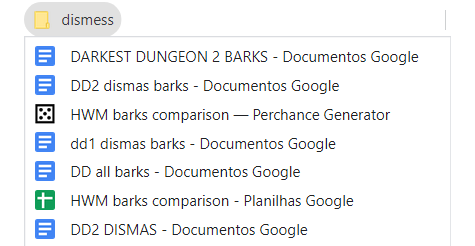
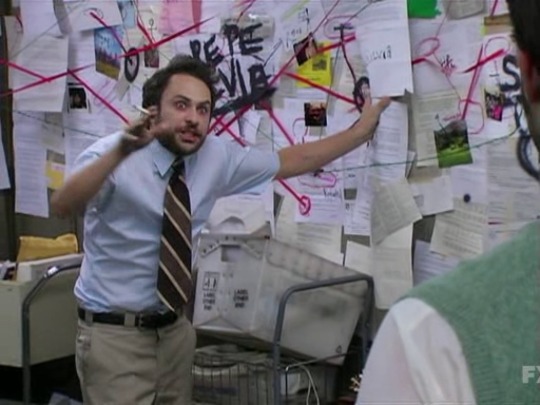
(Not a day goes by in which I don't feel like Charlie when it comes to DD2 Dismas.)
coffee-in-veins: aw, sorry that ask made you feel bad, that was definitely not my intention; sorry for that :{
Aww don't be sorry, you did nothing wrong!! I wanted to write about it, but like I said, I got overwhelmed-- probably because I feel very negatively about this, and this makes me feel small and petty, and then I wonder why I even care so much to begin with, and then I shut down and go play Hades until my hands hurt. Played 15 hours this week, my hands hurt so. Much.
So yeah, it's not your fault, I just can't deal very well with negative emotions lol
iceice-baeby: I don't like the game either, tbh. Maybe because the mechanics are different or my favourites are missing, maybe because of the weird romance mechanic?? (It just seems so tonally different, it clashes pretty hard with the rest of the game and I just don't think it fits, leave the shipping to the fandom :p) I don't even know all the character differences.
I have my issues with the relationship system, but I don't think the romantic aspect of it is weird or unfitting at all. People bond under adversity, there's nothing weird in that in my opinion.
My main complaints are: 1- the act outs need to be better balanced and more conditional (like, a character that could not/did not need to be healed should not complain about not being healed) and 2- desperately needs more barks. All of this can be improved as the game develops, it's already in way better shape than when it launched.
I don't mind the mechanics being different, they've made it pretty clear DD2 was not going to be Darkest Dungeon 1.5. I just have my doubts about the length of the acts. 4 to 6 hours playing with the same party is so tiring for me. I thought the addition of new enemies would change this, but you're still basically using the same moves on the same four heroes over and over and over, it doesn't take too long before it gets boring. Not to mention all the dead time we spend just travelling or waiting for the act outs to finish playing. And if you consider this is just act 1 out of 5, does this mean each full campaign will take around 20 to 30 hours?
I don't know. I love roguelites (played hundreds of hours of Slay the Spire and Hades), and what I love the most about them is the variety in each run. DD2 is still lacking this variety, and I'm not sure if adding more regions will help if you're still just using the same heroes the entire 4-6 hours. I'm not sure how could this be fixed in a satisfying manner though.
#darnest answers#it's easier for me to criticize gameplay mechanics#but when it comes to dismas things get personal lol
19 notes
·
View notes
Note
Follow up on the flipside: who do you consider the most OVERrated characters in RWBY? I realize this might be harder for you given how much you give good analysis of all the characters.
Oh lord lol! It's hard to say someone is overrated because people latch onto characters for various reasons and we may not understand but that's valid.
I'm just gonna go with the gods. I think they are not important, and I while I do get that they are basically responsible for this whole mess, I don't think they are villains and I don't think RWBY is at its core a cosmic anti-religion story about overthrowing the gods and having everyone live forever. Like. No. RWBY is at its core about humanity, including all its foibles and darkness and its light, and so why would there be a cosmic villain? It has no thematic sense. Would the humans not then become the new gods? Why would they do any better?
RWBY's major writing flaw I'd say is that it occasionally, particularly in the early seasons, portrayed the adults as incompetent to the point where it begged disbelief. But it wasn't setting them up as evil or to be cast aside (Qrow, even Oz, etc.) The gods to me seem like victims of this as well--their story with Salem seems shoddily executed to the point where yeah, we not only find Salem sympathetic (I think the point) but justified (I think not the point given the subsequent framing of Salem murdering her own kids lol).
But the story itself does not seem to be setting the gods up as anything other than nature. RWBY seems pretty deistic (a god who makes the world and then lets it run on its own; the watchmaker and the watch). I think the majority of people speculating about the gods are coming from a western cultural perspective wherein, regardless of personal belief or lack thereof, the idea of a personal God (as is present in Christianity) presents itself in numerous stories, justice system, education, and more. But RWBY doesn't portray characters praying or the gods as desiring anything in particular beyond balance. The one time someone makes a request of the gods it all goes to hell. It's just the wrong framework.
20 notes
·
View notes
Text
I want to expand a bit more on why I’m hesistant to seriously consider stuff like the Drug Business and exclusion of Americans in any narrative analysis of L’Manburg’s morality.
The thing about the Drug Empire is that - outside of being the inciting incident of the War of Independence - it’s always just played as a joke. It is never given any narrative weight. During the entirety of L’Manburg’s existence we never see a hint of consequences - on a larger narrative level - that arose from Wilbur’s and Tommy’s stated mission to establish a Drug Empire.
Like, Season 1 apes Hamilton, not Breaking Bad. If I’m supposed to see it as a fault against L’Manburg than why is there not a single plotline that even vaguely deals with that?
Similar with the exclusion of Americans. I have to be honest, I would have to reacquaint myself with the Election-Arc, because I know, that it was one of the reasons Quackity ran against Wilbur - but again, for something that is very heavy, it’s just grazed if anything.
The crux of the Election-Arc, at least how I remember it, was more the incredibly-rigged electoral system. Something, which was later recontextualised as Wilbur’s Mea Culpa specifically, as his inability to let go of his control over L’Manburg became, you know, the driving force of conflict in Season 1. So it’s hard for me to see that as a fault that’s inherent to L’Manburg and not to Wilbur’s character.
And a lot of this is, of course, owed to the fact, that the writing in those early parts of Season 1 had not solidified into the balance of drama and jokes that we had from the latter half of Season 1 onward. It erred more on the side of shenanigans than serious implications.
#dream smp#dream smp season 1#dsmp#dsmpblr#dreamsmp#l'manberg#l'manburg#lmanberg#lmanburg#dsmp analysis#dream smp analysis#wilbur soot#wilbursoot
165 notes
·
View notes
Text
TMBS Book 1 Brain Dump
~An Embarrassingly Long Post~
I don’t know why I’m writing this or why I’m so determined to do it. Maybe to finally assume my true form and become a mega dork on main, or maybe just for fun!
This is basically a compilation of all the main points running through my head after reading The Mysterious Benedict Society (2007) for the first time. Rather than posting a ton and spamming the tag, everything’s here in one neat package! (hopefully this gets it all out of my system rip)
Contents:
The Book Itself
The Book Itself, for real this time
The Characters
A Funny Parallel
The S.Q. Section
Lines & Scenes I Liked
Spoilers abound!
The Book Itself
Upon acquiring the first three books (don’t judge me pls), I was surprised at just how long they are. Like, they’re still pretty light being paperbacks and all, but these books are hefty lads.
The first book has this Disney+ Original Series circle thing printed on it, which is kind of unfortunate. Regardless, I love the cover illustration and yellow is actually my favorite color :D It made me weirdly quite happy whenever I saw the book lying around in my room
Also, it’s really cute how there’s a letter from Mr. Benedict at the end! (It only reveals that you can find out his first name if you “know the code”, meaning the bit of Morse printed below the summary on the back.) Shock and horror, though, as I realized I’m starting to recognize some of the letters

The Book Itself, for real this time
It’s wonderful how the tone of the book really shone through to the show adaptation. Something about the deliberateness of the aesthetic, from the set designs to the fashion to scene compositions, that really sells that particular style— like it’s very clear that this story is being told to us, rather than one we’re seeing unfold, if that makes sense.
Where that narration style stood out to me the most was the first chapter. We are told (rather than shown) how Reynie gets himself to the point of the second test, and there’s this whole twisty time maneuver for that whole sequence of events that’s really interesting
A super secret fun fact about me is that I wanted to be a writer when I was younger! So this particular balance of show vs. tell is really neat, since it runs counter to my own tendencies. The sheer amount of commas in every sentence is also kind of comforting, since Ahah, I Do That in those few serious-ish attempts at writing lol
Overall this book’s style reminds me a lot of Roald Dahl’s books, which are very nostalgic for me :D The whole “kids are more competent than adults” angle helps a lot too haha
The Characters
Oh boy here’s where I get a little bit critical! Overall I did really like this book!! it’s just that that expresses itself in all this weird “”analysis”” lol
Reynie - much better in the books than in the show
It’s sort of a lukewarm take but I feel like show!Reynie is kind of boring? He doesn’t have a lot going on flaw-wise, and obviously since he’s the protagonist he can’t have too many weird traits or else the kids watching can’t project themselves onto him as easily
(I call it the difference between an aspirational protagonist and a vessel protagonist. Going off of the Roald Dahl vibes, think Matilda vs Charlie. show!Reynie is more of a Charlie)
Thus when we get to see him really struggle with the Whisperer and doubt himself it gives him a lot more dimension, at least in my opinion
It is a federal crime that the white knight scenes were not adapted into the show
Sticky - my son
I’ve long held to no one besides myself and my long suffering sister that Sticky is The Best Member of the Society
He happened to hit a lot of the Bingo squares of Stuff I Like In Characters: glasses, anxious, nice :), kind of a coward but ultimately is there for his friends, etc
For some reason I don’t talk about him nearly as much as you-know-who, but I love him just as dearly
Kate & Constance - I don’t have much to say
Kate is really interesting in this book! I like how we get to see more of her depths, in particular that one passage about her belief that she is invincible being the only thing that keeps her from falling apart? :c
Also her constant fidgeting is relatable lol
Constance is somehow a lot more tolerable in the book. I think I’m just one of those people with no patience for small children, unfortunately lol
(Some of) The Adults
It’s interesting that they had such an offscreen presence for most of the book. Giving them more time was probably one of the stronger changes of the show
However if that decision was made at the expense of the white knight scenes I think the choice should have been clear
I like the way Rhonda and Number Two are written
Milligan always on sad boy hours 😔✊
The “mill again” passage is touching but kind of messes up the pacing of the getaway, at least for me. Maybe I should read it again to make sure I didn’t miss something
Miss Perumal is much better in the show. We see so little of her in the book she doesn’t function well as an emotional anchor for Reynie, imo
The Institute Gang
Jackson and Jillson serve their purpose well, and Martina was surprising to say the least. I like the direction they took her in the show! I can’t imagine how funny it must have been to watch the tetherball subplot come out of nowhere lolol
These sections were written out of sequence, so random tidbit I couldn’t fit in The S.Q. Section: I like how he stumbles over his words. relatable
Mr. Curtain
While I think I know why they decided to not give Curtain the wheelchair in the show, we were totally robbed of Actor Tony Hale’s performance for the reveal during the final confrontation
Speaking of the wheelchair, it’s such a powerful symbol of his need for control or rather, his fear of losing it
The Contrast between him and Mr. Benedict. This point is expanded on in A Funny Parallel
Mr. Benedict
Oh boy, Mr. Benedict… How do I say this
I find it hard to trust Mr. Benedict, unfortunately
I mean to say, I do in the sense that I know he would never hurt the kids, thanks to knowing that a) this is a children’s book series and b) the meta (tumblr) states that he is really nice and lovable and stuff, but seriously. Why do the kids trust him at first?? I probably missed something somewhere
I like to think I’m an optimistic person, but unfortunately I’m also super paranoid. The premise of “a bunch of vulnerable orphans team up with a strange old man” is just so odd to me I don’t know how to explain it
I don’t know!!! I really want to trust Mr. Benedict
One of the strengths of the show is that we get to see him more often, and thus he gets to acknowledge more often that the plan is weird and that he feels really badly for putting the kids in danger and that he’s trustworthy and genuine
But his lack of presence for most of the book just makes him into something of a specter, invisible and unknowable, speaking only in riddles from across the bay
Which is why the white knight scene is so important!! I loved that scene ;-;
Because here’s an actual emotional connection! We can actually see it happening, rather than only being told that it exists
Reynie asking for advice and receiving encouragement, in words that demonstrate that Mr. Benedict actually cares about him and worries about him and agghh
It is a federal crime that the white knight scenes were not adapted into the show
But overall this whole issue didn’t ruin my enjoyment of the book at all! It’s just ->
A Funny Parallel
Okay, ready for my biggest brain, hottest take ever??
Mr. Benedict and Mr. Curtain…. are… the same
I mean obviously not entirely, given that one is benevolent and kind and the other is… Mr. Curtain
But seriously. Genius old man seeks out children (mainly orphans) to enact a plan. Said children often end up incredibly devoted to his cause and deeply admire him this is a little flimsy
Undoubtedly that’s intentional and is supposed to show the difference between them, like some kind of cautionary tale? “Let yourself be vulnerable and let others help you, lest you turn eeeeviiillll”
I guess that’s where the aforementioned epic contrast comes in. You get Mr. Curtain, strapped into his wheelchair and hiding behind those mirrored sunglasses, terrified (but unwilling to admit it) of ever showing the tiniest hint of vulnerability, vs. Mr. Benedict, who can let himself fall knowing that someone will catch him :’)
Anyhow I have nothing against the parallels, I just think it’s funny
The S.Q. Section
The S.Q. Quarantine Thread so it doesn’t leak out everywhere else <3
I’d like to meet the emo angstlord genius who read this book and decided to make SQ into Dr. Curtain’s son. What in the world
Okay I should probably preface this by saying that I absolutely adore both book!S.Q. and show!SQ with all my heart. Somehow, despite being a completely different character in both mediums, he has managed to be one of the best characters in either and certainly one of my favorites (besides Sticky of course) in the entire franchise, despite the fact that I’ve only read the first book/watched the show so far. I am confident in this statement.
But seriously! How?? Why?? I could probably write a whole other essay about why show!SQ is such an interesting character, and the change works so incredibly well. I’m just. Baffled
Okay, focus. book!S.Q. is such a sweetheart, oh my goodness. Like, 100% one of the most endearing characters in the book. Poor guy. I don’t even know where to start!!
He just seems to be a genuinely good guy at heart, despite being technically one of the bad guys. He’s genuinely happy for Reynie and Sticky when they became Messengers and helped Kate when she “fell” and was concerned about Constance when she looked sick and how he was in that meeting with Mr. Curtain and Martina?!!? aaahhhhghgh ;-; he just wants people to be happy TT-TT
Comparing him against literally every character at the Institute is probably what makes him so endearing tbh. When everyone else is so awful to the kids, it really makes him stand out. Like a cheerful little nightlight in the worst, most humid and rank bathroom you’ve ever been in
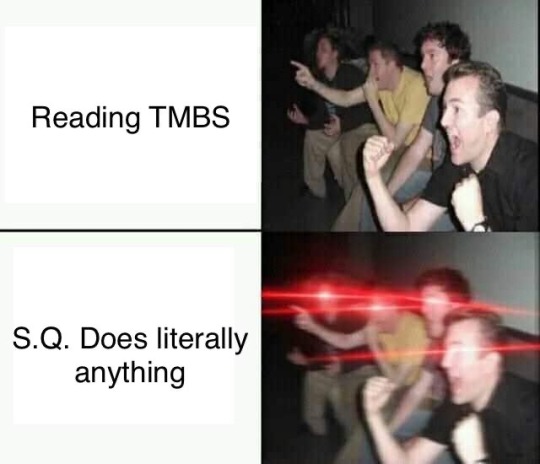
It’s kind of pointless to theorize about a book series that’s already concluded (I think?) but. Is the implication of S.Q.’s forgetfulness supposed to be that Mr. Curtain used him in brainsweeping experiments somehow? The timeline probably definitely absolutely doesn’t line up but like. How did he get to being a Messenger being the way he is now, given how cutthroat the process is? And then of course Mr. Curtain keeps him around as an Executive because he’s fun to mess with and presumably his loyalty. I’m very curious as to how their relationship develops in the other books, if at all. Those are probably where the seeds of the “let’s make them family” logic were planted
But wouldn’t it be hilarious if the reason we don’t know what “S.Q.” stands for in the books is that he just. Forgot
Another thing that occurred to me. Given that he and the other Executives were Messengers at some point, what were their worst fears? What is S.Q.’s worst fear?? Inquiring minds need to know
One last horrible little anecdote: I was thinking about book!S.Q. while eating breakfast, as one does, and suddenly it hit me.
I want to believe The Author Trenton Lee Stewart had the name for a character, S.Q. Pedalian, and was like, “Hm! What sort of quirky trait should this young fellow have?” Because, of course, in this style of fiction every character has to have at least one cartoonish or otherwise distinguishing trait to stand out in the minds of children. (For instance, Kate has her bucket, Sticky has his glasses, Constance is angry, and Reynie is Emmett from the Lego Movie)
Anyhow, he looks around the room, searching for inspiration. Suddenly he comes across a jumbo box of plastic wrap. Completely innocuous in design, save for one line of text. 300 SQ FT.
“…large… S.Q. …feet? THAT’S IT!” i’m sorry
Lines & Scenes I Liked
In no particular order!
Sticky quotes Sun Tzu, The Art of War
Evil combination aerobics/square dancing in the gym with the Executives
Everyone being happy at the end :’)
Everyone partying after Sticky reunites with his parents, and later finding Mr. Benedict asleep at his desk from the moment they shook hands :’’)
Literally any scene with Sticky in it
Any time Kate says “you boys” or “gosh”
[“Um, sir?” S.Q. said timidly, raising his hand. “A thought just occurred to me.” / Mr. Curtain raised his eyebrows. “That’s remarkable, S.Q. What is it?”] clown prince of my heart </3
S.Q.’s determined monologue about searching for clues after he bungled up the first time
Literally any scene with S.Q. in it (please refer to The S.Q. Section)
Reynie trying to resist the Whisperer.
[Let us begin. / First let me polish my spectacles, Reynie thought. / Let us begin. / Not without my bucket, Reynie insisted. He heard Mr. Curtain muttering behind him. / Let us begin, let us begin, let us begin. / Rules and schools are tools for fools, Reynie thought.]
NO MORE HURTIN’ WITH CURTAIN
Milligan showing up on the island!!
Remember the white knight hhhhhh
“controle”
A Super Secret Bonus Section
I would be extremely surprised if anyone read through all the way down here lol. Regardless, here’s a little acknowledgements section :D not tagging anyone since I don’t want to bother all of these people
Special shoutout to tumblr blog stonetowns for unknowingly yet singlehandedly demolishing my reluctance to read the books by posting a ton of cute quotes. Thank you for your service o7
Thanks to the two OGs that liked the post I made right before this one, for being my unwitting enablers and for sticking around despite being a) technically an internet stranger (hello!) and b) someone I haven’t spoken to irl in literal years (hey!!)
Last but not least thankz 2 my sister for putting up with me ranting about the book when I first got it and for asking about “CQ” sometimes lol. (i desperately hope you’re not reading this orz)
#the mysterious benedict society#this took me like three days to finish rip#it’s worked though! i feel less of a Mighty Need to think about this stuff constantly now#however!!! today through some conniving i have gotten the Second Book#now I’m at 3 out of 4 infinity stones. muahahaha#was going to include my villain origin story about why i like show!SQ so much but cut it for being too long and irrelevant. however#if the words jeff naomi and Sweet Dreams are Made of These mean anything to you please hit me up. it’s kind of a funny story
31 notes
·
View notes
Photo
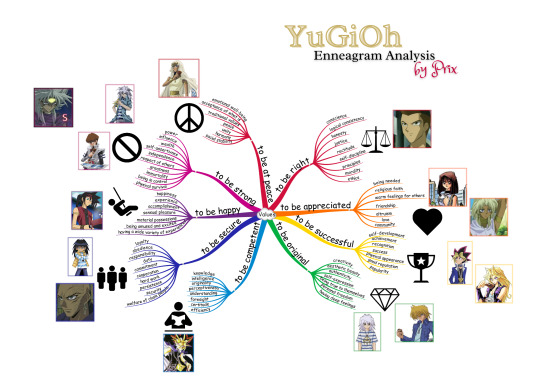
[ID: A chart describing the core values of each of the nine Enneagram personality types with YuGiOh characters correlated to each of the types.]
YuGiOh Enneagram Analysis, Part #1
Please note that this is the “boring” informational post about Enneagram with the Types listed and explained as well as a few other things. The next post is what has the actual, in-depth character profiles promised!
Introduction & Motivation
Over the past several months, I have been trying to analyze my strengths and weaknesses as a writer and learn more. I have been writing fanfiction since I was a little kid, making my first FF.net account in 2003 when I would have been twelve years old. Even before that, I was a lurker and wrote fics to share with my childhood best friend on paper or floppy discs.
YuGiOh came into my life at some point shortly thereafter. I know this, because I spent my thirteenth birthday in a comic book shop, mostly watching some of my male friends play the trading card game. I had some of the cards, but I was never much of a player, unable to keep up with the seemingly rapid rule changes. Besides that, I was always way more interested in the story and characters than I was in the card game. I remember I even wanted to call “YuGiOh cards” “Duel Monsters” instead to make it seem a little closer to tween-y LARPing.
Eventually, I gave up on collecting cards or trying to ply the game. I felt that while my male friends didn’t mind me being around when they played, they weren’t extremely interested in helping me learn or keep up. I felt I had other strengths, so I started carrying around a notebook even more than I already did. I started my fledgling forays into online fandom. And YuGiOh was a big part of the beginning of that.
I can’t remember posting any YuGiOh fic in particular, and I’m sure that if I had it would make me cringe now. What I do remember is reading some and also spending a lot of time lying on my bed, headphones plugged into a small purple stereo, listening to the first of the two American-released CDs with YuGiOh-inspired music on them. In particular, the last three tracks were pieces of music from the original score composed for the 4Kids dub, which is - for some reason - different from the original Japanese music.
During that time, I would fantasize and conjure my own YuGiOh plots in my head, most of which were focused on the Ancient Egyptian and more spooky, spiritual, and horror themes in the show. I was really fascinated with the reincarnation angle, though my understanding of and opinions on how that works have grown with time.
Years went by, and I didn’t think about YuGiOh much at all. Then, something happened in 2018. I don’t know what got in my head, but it was like all the joy I once found in thinking about the YuGiOh characters came back in a giddy conversation with my childhood best friend. Then, for a little while, it wouldn’t leave me alone.
I started writing for the fandom then, and after several detours, I’m trying to get back in the groove of it.
My approach to the tone of YuGiOh-fanning is that it’s a bit serious, but it’s also with a tongue placed in my cheek because of how incomprehensible or silly the plot can be on a meta level. Sometimes, it almost brings tears to my eyes by being so over-the-top about something that, in the real world, would make no sense at all. But the drama, in the context of the universe, somehow rings true.
I think that’s all owing to how most of the primary characters are just... really freaking great characters.
It has often puzzled me. Like, did Takahashi do all this layering on purpose? Is it really there, or did earnest fanon just make it seem like it? And, as a person, I am always here for a good fan-and-canon symbiosis.
This post is going to be, from here on, an effort to match the YuGiOh characters to the 9 Enneagram Personality Types. I am writing this for my own benefit as I continue to work on my pet YuGiOh fanfiction project, It’s Always Sunny in Domino City, which is a mixture of YGOTAS-vibes-and-concepts taken seriously and a sincere take on fanfiction for the actual canon. It’s dramedy about a sizeable chunk of the main cast a few years post-canon with some canon divergence such as the Memory World arc not yet and possibly never-happening. If that sounds like something you’d like, I would humbly request you check it out!
Either way, this will be an in-depth character analysis cheatsheet for all of the characters above, based on my observations, opinions, and feelings. I invite discussion, but it’s fine if we need to agree to totally disagree!
If you are interested and enjoy what’s below the Read More and in the coming second post, then you are welcome to utilize the character analyses to aid you in your own fanwork!
Enneagram
What is Enneagram, and why am I using it?
Enneagram is a personality categorization system that one might compare to the somewhat better-known MBTI. However, in the words of excellent writing-advice YouTuber, Abbie Emmons:
MBTI shows us how we behave.
Enneagram shows us what we believe.
I will be referencing Abbie’s video Using The ENNEAGRAM To Write CONFLICTED CHARACTERS and her free Enneagram-cheatsheet, available in the description of the linked video. Whether it’s before you continue reading or after, if you’re interested in writing, I would highly recommend you check out her channel!
The Enneagram system has nine basic personality types that overlap and interact in really interesting ways. It is not a hard science, and it’s not a horoscope. Instead, it’s supposed to be “based on conventional wisdom and modern psychology.” All I can say is that with every set of characters I’ve tried it with, it works! Once you get the hang of it, it feels kind of like ~✰~magic~✰~!
Below, I will list Abbie’s simplified definitions of each of the personality types, in order:
Type 1: The Reformer
The Rational, Idealistic Type:
Principled, Purposeful, Self-Controlled, and Perfectionistic
Basic Fear: Of being corrupt/evil, defective
Basic Desire: To be good, to have integrity, to be balanced
Key Motivations: Want to be right, to strive higher and improve everything, to be consistent with their ideals, to justify themselves, to be beyond criticism so as not to be condemned by anyone.
Type 2: The Helper
The Caring, Interpersonal Type:
Generous, Demonstrative, People-Pleasing, and Possessive
Basic Fear: Of being unwanted, unworthy of being loved
Basic Desire: To feel loved
Key Motivations: Want to be loved, to express their feelings for others, to be needed and appreciated, to get others to respond to them, to vindicate their claims about themselves.
Type 3: The Achiever
The Success-Oriented, Pragmatic Type:
Adaptable, Excelling, Driven, and Image-Conscious
Basic Fear: Of being worthless
Basic Desire: To feel valuable and worthwhile
Key Motivations: Want to be affirmed, to distinguish themselves from others, to have attention, to be admired, and to impress others.
Type 4: The Individualist
The Sensitive, Introspective Type:
Expressive, Dramatic, Self-Absorbed, and Temperamental
Basic Fear: That they have no identity or personal significance
Basic Desire: To find themselves and their significance (to create an identity)
Key Motivations: Want to express themselves and their individuality, to create and surround themselves with beauty, to maintain certain moods and feelings, to withdraw to protect their self-image, to take care of emotional needs before attending to anything else, to attract a "rescuer."
Type 5: The Investigator
The Intense, Cerebral Type:
Perceptive, Innovative, Secretive, and Isolated
Basic Fear: Being useless, helpless, or incapable
Basic Desire: To be capable and competent
Key Motivations: Want to possess knowledge, to understand the environment, to have everything figured out as a way of defending the self from threats from the environment.
Type 6: The Loyalist
The Committed, Security-Oriented Type:
Engaging, Responsible, Anxious, and Suspicious
Basic Fear: Of being without support and guidance
Basic Desire: To have security and support
Key Motivations: Want to have security, to feel supported by others, to have certitude and reassurance, to test the attitudes of others toward them, to fight against anxiety and insecurity.
Type 7: The Enthusiast
The Busy, Variety-Seeking Type:
Spontaneous, Versatile, Acquisitive, and Scattered
Basic Fear: Of being deprived and in pain
Basic Desire: To be satisfied and content—to have their needs fulfilled
Key Motivations: Want to maintain their freedom and happiness, to avoid missing out on worthwhile experiences, to keep themselves excited and occupied, to avoid and discharge pain.
Type 8: The Challenger
The Powerful, Dominating Type:
Self-Confident, Decisive, Willful, and Confrontational
Basic Fear: Of being harmed or controlled by others
Basic Desire: To protect themselves (to be in control of their own life and destiny)
Key Motivations: Want to be self-reliant, to prove their strength and resist weakness, to be important in their world, to dominate the environment, and to stay in control of their situation.
Type 9: The Peacemaker
The Easygoing, Self-Effacing Type:
Receptive, Reassuring, Agreeable, and Complacent
Basic Fear: Of loss and separation
Basic Desire: To have inner stability, "peace of mind"
Key Motivations: Want to create harmony in their environment, to avoid conflicts and tension, to preserve things as they are, to resist whatever would upset or disturb them.
Now that you’ve seen all those, what do you think your favorite character is? In YuGiOh or anything else! It works great for original characters and even yourself and your loved ones.
The actual Character Profiles will be in coming post(s), but continue reading if you want me to explain more about how and why the Enneagram is a great personality typing system. #nonspon, or whatever.
The Enneagram Chart
Now, you could just go to the Enneagram Institute’s page on How the System Works, but below I’ll cut it down to only the parts I’m interested in and explain those in a way that helps me.
Unlike in astrology or MBTI, which are both more restrictive in different ways, the relative position of each type matters a bit on the Enneagram chart, because it can be used to visualize a lot of things about a person!
The Basic Chart
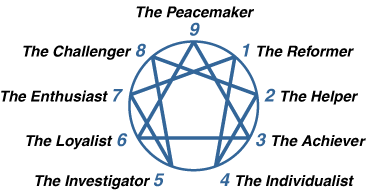
The Types are shown in a clockwise fashion with “1″ in the 1 o’clock position on an analog clock. The interior lines mean things, but I have trouble reading it without further delineation.
Centers of Response
Below are two small charts, displayed side-by-side. (If it’s too small, try right-click, open in new tab!)
The chart on the left shows the three “centers.” The “centers” indicate the first ‘processing language’ a person would use to respond to stimuli.
Type 8, Type 9, and Type 1 respond first based on instinct (primal, gut-feeling). If you want to go Freudian, this is from the id.
Type 2, Type 3, and Type 4 respond first based on feelings (social or personal desires, the heart). If you want to go Freudian, this is from the ego.
Type 5, Type 6, and Type 7 respond first based on thoughts (analytical rather than emotional, the head). If you want to go Freudian, this is from the superego.
Remember that, of course, every single type and person engages their instincts, their emotions, and their thoughts at different times and to different degrees, and some of these are learned or changed behaviors. This is about what their innate drive toward that would be.
Likewise, the same “centers” can also be used for the chart on the right. You will notice that all three of these are defined by what is typically considered a negative emotion. This is because this is about a person’s instinctive, not particularly conscious emotional response when they are backed into a corner and deprived of something that is core to the needs of their personality type.
Type 8, Type 9, and Type 1 tend to respond to a threat to their psychic well-being with anger/rage.
Type 2, Type 3, and Type 4 tend to respond to a threat to their psychic well-being with shame.
Type 5, Type 6, and Type 7 tend to respond to a threat to their psychic well-being with fear.

Stress vs. Growth
We all know that there are times when a person isn’t acting like themselves, for better or for worse. Usually, “You’re not acting like yourself,” means that a person is behaving badly. Of course, it’s way easier to withdraw and bristle and defend rather than growing in the midst of adversity. However, it is certainly possible to experience character growth in response to experiences, good and bad. Unlike a lot of other personality typing schemes, the Enneagram has a way to display and predict what stress and growth do to a person.
The Enneagram never suggests that any Type is an island unto itself. Every person contains multitudes, but a person’s Type is likely to remain relatively stable throughout their lives, once they have had a chance to develop any personality at all. This means that when a person is stressed or growing that they do not become the type they emulate. Rather, they are more highly expressing that aspects of their personality that reflect those drives and desires but in a way that is either fraught, sickly, or unwell (in the case of stress), or aspirational, flying-high, and incorporating the hard-lessons into who a person is going to be going forward (in the case of growth). The latter, especially, isn’t a sustainable mode, while a stressed person can become more entrenched in their bad habits and defensive coping mechanisms.
Stress
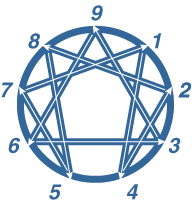
Note the white, directional arrows. Each number has an arrow point pointing to it and an arrow leading away from it. The point indicates that this is the stress manifestation for the Type at the origin of that arrow. The origin of each arrow indicates the Type being described.
Confused? Let me finally give you a YuGiOh example.
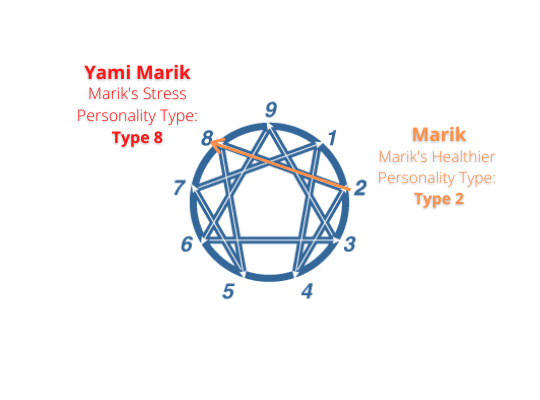
When I was trying to identify the Types of the characters, defining Marik was difficult, because he has a “Yami,” or Dark Side, which has its own personality and will but which is not its own separate soul or person than Marik himself. Rather, it’s a kind of fantasy/magic-assisted personality splintering where Yami Marik is a full manifestation of the negative traits Marik needed to embody to survive.
So, for reference:
When stressed, Type 1 behaves more like Type 4.
When stressed, Type 2 behaves more like Type 8.
When stressed, Type 3 behaves more like Type 9.
When stressed, Type 4 behaves more like Type 2.
When stressed, Type 5 behaves more like Type 7.
When stressed, Type 6 behaves more like Type 3.
When stressed, Type 7 behaves more like Type 1.
When stressed, Type 8 behaves more like Type 5.
When stressed, Type 9 behaves more like Type 6.
Alternatively, you can use these sequences to follow the stress lines:
1-4-2-8-5-7-1
9-6-3-9
Growth
Think of the above-explanation in reverse.
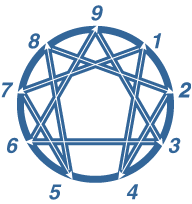
The sequence:
1-7-5-8-2-4-1
9-3-6-9
As a Type 1 grows, they incorporate more positive traits of Type 7.
As a Type 2 grows, they incorporate more positive traits of Type 4.
As a Type 3 grows, they incorporate more positive traits of Type 6.
As a Type 4 grows, they incorporate more positive traits of Type 1.
As a Type 5 grows, they incorporate more positive traits of Type 8.
As a Type 6 grows, they incorporate more positive traits of Type 9.
As a Type 7 grows, they incorporate more positive traits of Type 5.
As a Type 8 grows, they incorporate more positive traits of Type 2.
As a Type 9 grows, they incorporate more positive traits of Type 3.
Wings
The final thing to know about the Enneagram chart for my purposes is about wings. The wing of your personality traits accounts for the complementary and contradictory aspects of your personality. They are the inconsistencies that make you human, predicted and jumped in. Typically, a person is not thought to have both possible wings but one or the other. A wing is one of the two adjacent Types to yours, the number before, or the number after, and it is annotated, for example:
Type 1, Wing 2: 1w2
Type 1, Wing 9: 1w9
Link to Part 2 Here!
#yugioh#yugi mutou#seto kaiba#jounouchi katsuya#yugioh duel monsters#mutou yugi#kaiba seto#kaiba mokuba#mokuba kaiba#kujaku mai#mai kujaku#anzu mazaki#mazaki anzu#katsuya jounouchi#marik ishtar#isis ishtar#rashid ishtar#hiroto honda#honda hiroto#ryou bakura#bakura ryou#yami bakura#yami marik#yami yugi#pharaoh atem#atem#ryuji otogi#otogi ryuji#main cast#op
37 notes
·
View notes